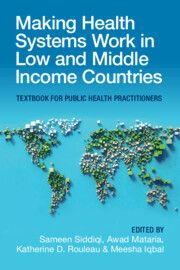 Making Health Systems Work in Low and Middle Income Countries
Making Health Systems Work in Low and Middle Income Countries Book contents
- Making Health Systems Work in Low and Middle Income Countries
- Reviews
- Making Health Systems Work in Low and Middle Income Countries
- Copyright page
- Dedication
- Contents
- About the Editors
- Contributors
- Preface
- Section 1 Analyzing Health Systems: Concepts, Components, Performance
- Section 2 Transforming Health Systems: Confronting Challenges, Seizing Opportunities
- Chapter 15 Universal Health Coverage and Beyond
- Chapter 16 Pro-Poor Expansion of Universal Health Coverage
- Chapter 17 Health Insurance for Advancing Universal Health Coverage
- Chapter 18 From Passive to Strategic Purchasing in Low and Middle Income Countries
- Chapter 19 Good Governance and Leadership for Better Health Systems
- Chapter 20 Developing a Balanced Health Workforce
- Chapter 21 Enhancing Equitable Access to Essential Medicines and Health Technologies
- Chapter 22 Health Information and Information Technology
- Chapter 23 Using Health Research for Evidence-Informed Decisions in Health Systems in L&MICs
- Chapter 24 Integrated People-Centered Health Care
- Chapter 25 Strengthening Hospital Governance and Management to Become High-Performing Organizations
- Chapter 26 Improving the Quality and Safety of Health Care in Low and Middle Income Countries
- Chapter 27 Harnessing the Contribution of the Private Health Care Sector toward Public Health Goals
- Chapter 28 Public–Private Partnership in Health Care Services
- Chapter 29 Embedding People’s Voice and Ensuring Participatory Governance
- Chapter 30 Achieving Health-Related Sustainable Development Goals
- Chapter 31 The Determinants of Health Systems
- Chapter 32 Integrating Essential Public Health Functions in Health Systems
- Chapter 33 Engaging in a Health Care Recovery Process
- Chapter 34 Health System Response to the COVID-19 Pandemic
- Chapter 35 Understanding the Global Health Architecture
- Chapter 36 Political Economy of Health Reforms in Low and Middle Income Countries
- Chapter 37 Better Health Systems for Better Outcomes
- Index
- References
Chapter 27 - Harnessing the Contribution of the Private Health Care Sector toward Public Health Goals
from Section 2 - Transforming Health Systems: Confronting Challenges, Seizing Opportunities
Published online by Cambridge University Press: 08 December 2022
- Making Health Systems Work in Low and Middle Income Countries
- Reviews
- Making Health Systems Work in Low and Middle Income Countries
- Copyright page
- Dedication
- Contents
- About the Editors
- Contributors
- Preface
- Section 1 Analyzing Health Systems: Concepts, Components, Performance
- Section 2 Transforming Health Systems: Confronting Challenges, Seizing Opportunities
- Chapter 15 Universal Health Coverage and Beyond
- Chapter 16 Pro-Poor Expansion of Universal Health Coverage
- Chapter 17 Health Insurance for Advancing Universal Health Coverage
- Chapter 18 From Passive to Strategic Purchasing in Low and Middle Income Countries
- Chapter 19 Good Governance and Leadership for Better Health Systems
- Chapter 20 Developing a Balanced Health Workforce
- Chapter 21 Enhancing Equitable Access to Essential Medicines and Health Technologies
- Chapter 22 Health Information and Information Technology
- Chapter 23 Using Health Research for Evidence-Informed Decisions in Health Systems in L&MICs
- Chapter 24 Integrated People-Centered Health Care
- Chapter 25 Strengthening Hospital Governance and Management to Become High-Performing Organizations
- Chapter 26 Improving the Quality and Safety of Health Care in Low and Middle Income Countries
- Chapter 27 Harnessing the Contribution of the Private Health Care Sector toward Public Health Goals
- Chapter 28 Public–Private Partnership in Health Care Services
- Chapter 29 Embedding People’s Voice and Ensuring Participatory Governance
- Chapter 30 Achieving Health-Related Sustainable Development Goals
- Chapter 31 The Determinants of Health Systems
- Chapter 32 Integrating Essential Public Health Functions in Health Systems
- Chapter 33 Engaging in a Health Care Recovery Process
- Chapter 34 Health System Response to the COVID-19 Pandemic
- Chapter 35 Understanding the Global Health Architecture
- Chapter 36 Political Economy of Health Reforms in Low and Middle Income Countries
- Chapter 37 Better Health Systems for Better Outcomes
- Index
- References
Summary
Private hospitals, clinics, and pharmacies, and the doctors, nurses, and other medical personnel who staff them provide a large portion of healthcare services in low- and middle-income countries (L&MICs). In some, the private sector delivers much more care than the government. Understanding the scale, capacity, quality, constraints and motivations of private providers and private facilities – whether for-profit, non-profit, formal or informal – is critical to assuring that health services and medicines support and expand the goals of access to quality health care for all. This chapter sets out what is known regarding private care provision, from world-class hospitals to unlicensed and untrained village drug-sellers and summarizes the experience and frameworks being applied around the world to measure, regulate, and assure the efficient and effective provision of private health care as part of mixed-health-systems in L&MICs. In many settings the challenges of private sector governance are complicated by limited data, minimal financial transfers, and weak regulatory systems. Despite this, advances have been made in L&MICs to defining and applying good governance strategies.
Keywords
- Type
- Chapter
- Information
- Making Health Systems Work in Low and Middle Income CountriesTextbook for Public Health Practitioners, pp. 421 - 434Publisher: Cambridge University PressPrint publication year: 2022
References
- 1
- Cited by


